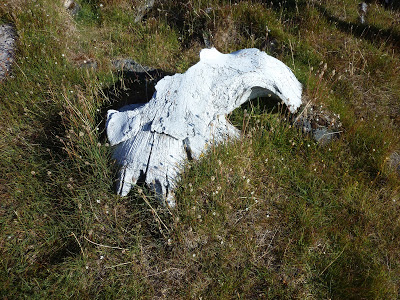by Baxter
 |
| Whale Bone by Michele Macartney-Filgate |
Be it lower back, middle back, upper back or neck pain, not a day goes by when at least one student offers up his or her particular version of back pain. Due to the effects of time, age and stress on the spine, one of the underlying causes of back pain is arthritis of the spine. To be more specific, we usually refer to it as “osteoarthritis of the spine” to differentiate it from other types of arthritis that may be due to autoimmune conditions. Sounds specific, maybe even helpful to have a label to attach to one’s problem, but what does “arthritis” refer to? Well, it is an “itis,” so there’s a clue. “Itis” usually implies some inflammatory process, you know, like tendonitis, where the tendon is inflamed.
In arthritis, it is the boney structures and their coverings, usually cartilage, that are involved. In a healthy joint, anywhere in the body, the ends of two bones that make up a joint are covered with a protective coating of connective tissue known as cartilage, which acts as both a cushion between the two bones, and as a smooth, slippery surface that can slide and glide as the bones move over one another during motion. Here’s where time, age, stress and other factors ruin a perfectly good system. Over time, with the aging process (which can dry out and thin the cartilage independent of the other factors), and with certain movement patterns (especially unusual, misaligned ones) and repetitive use, especially with additional stress from gravity or carrying loads, the cartilage can fray and thin and outright wear away. This exposes bare bone, which is not that smooth and slippery, and leads to the “itis” or inflammatory process we feel as “arthritis” via the symptoms of stiffness, immobility and pain.
When talking about the spine specifically, the places where two spinal bones, or vertebrae, meet include the donut-like intervertebral discs (which I will refer to as discs from now on), which sit between two adjacent “bodies” of the vertebral bones, in vertical relationship, and the two posterior facet joints, right and left, whose smaller surfaces are covered by a thin coating of cartilage. The most common area for arthritis in the spine is in the lowest part of the lower back, or lumbar region, due to extra effects from gravity of holding up the belly, torso, head and arms. The next most common area is the neck area or cervical spine, likely due to its incredible mobility and relatively short intervertebral discs. The thoracic area or rib cage region of the spine is often affected when two other complicating factors are present: scoliosis, or curvature of the spine, and osteoporosis, or thinning of the bones. I’m sure there will be more on those topics at another time.
Coming back to the discs for a minute, all the cumulative factors mentioned above can cause these guys to lose their normal integrity, resulting in the discs losing water and drying out, which increases the risk of them breaking open or rupturing their tougher outer ring known as the annulus fibrosis (even sounds tough!) and extruding or pushing out their inner contents, which is the gel-like inner part, the nucleus pulposa, often compared to the jelly in a jelly-filled donut. The discs also lose some of their height, which normally helps to keep a healthy distance between two vertebrae. This can then result in the facets rubbing more closely together, the opening for nerves narrowing enough to start pinching on nerves, and other such difficulties! When that nucleus pulposus material is released into the spinal canal, which sits just back of the discs and where your spinal cord descends down from the brain to the tail bone, it causes a local flare of inflammation that can last a while. When the disc is losing height but does not rupture, we call that degenerative disc disease (a bit of a misnomer, as it may not be a disease per se, but more like a natural aging process of the disc). This alone can result in pain for some, and it can be found in adults starting in their thirties!
How’s yoga supposed to improve this arthritis situation of the spine? Well, those of you who have been in class with me lately have heard me use the phrase “the prime directive.” Sounds a bit Star Trek-y doesn’t it? But in this setting, it refers to the inner action of creating an even lift from the base of the body, either the tailbone or the sitting bones, up through the whole length of the spine to the crown of the head. This is technically known as axial extension, and, according to Leslie Kaminoff, it does create a longer spine, even as it slightly diminishes the amount of natural arch in each region of the spine. That is, it straightens the spine a bit, but not entirely. And it requires some muscular effort, especially if you have not been practicing it. You can do this anywhere, anytime, and if you are doing it and paying attention to how it feels as well as, perhaps, how it affects your breath, and you remain connected to the action for a bit, you have a mini yoga practice under way.
And then from there, you can take the spine through some gentle range of motions, via some easy, basic yoga poses, such as Cat/Cow pose, Child’s pose to low Cobra pose, Standing Side Bend (sometimes called New Moon pose), and gentle reclining or seated twists. As you do this, you are always assessing the effect on the area of your spine that is sensitive, modifying the intensity, range of motion or number of repetitions or length of holding to make it appropriate for you situation. I believe that a while back Shari mentioned that movement actually hydrates, nourishes and revitalizes the discs of the spine, so inactivity is not a great option, is it? (See Yoga for Osteoarthritis for an interview with Shari about arthritis.). So let’s get moving, yogis! Great to be back from spring break. More good stuff tomorrow! See Arthritis of the Spine, Part 2 for more poses you can do to find relief from back pain and to lengthen your spine.
Follow Yoga for Healthy Aging on Facebook ° To order Yoga for Healthy Aging: A Guide to Lifelong Well-Being, go to Amazon, Shambhala, Indie Bound or your local bookstore.


Leave A Comment